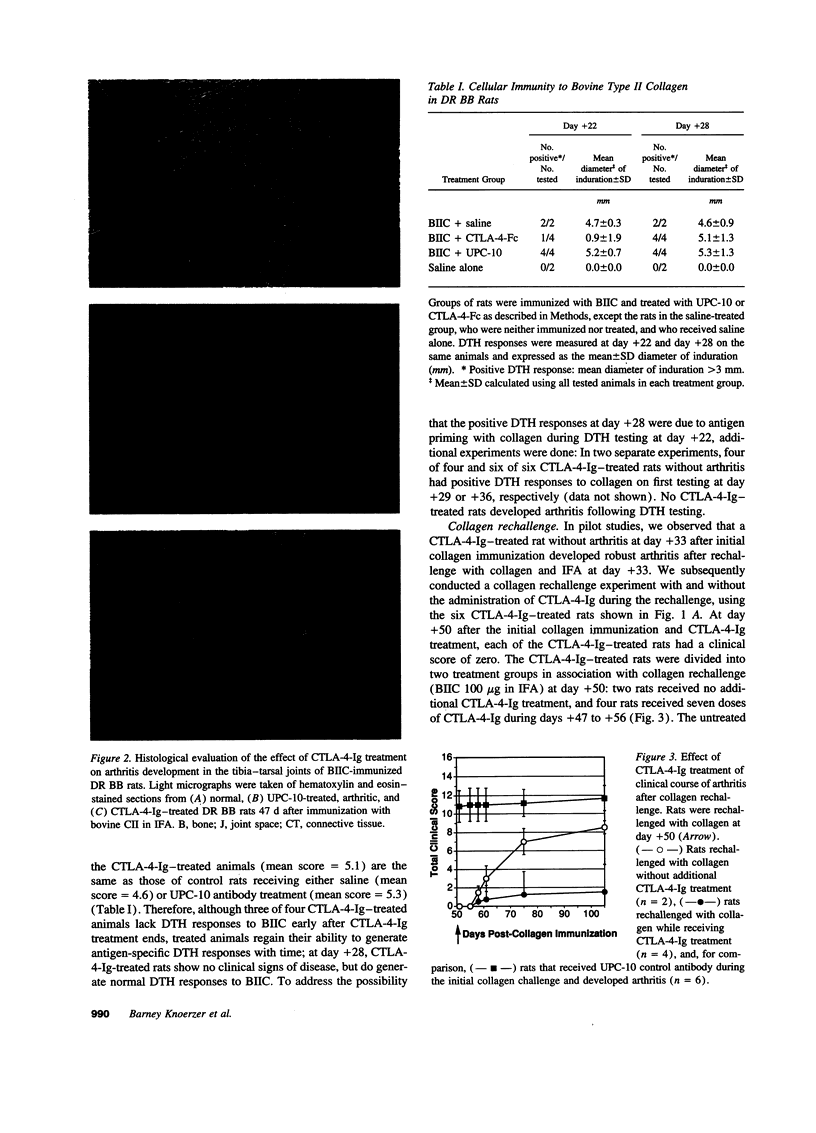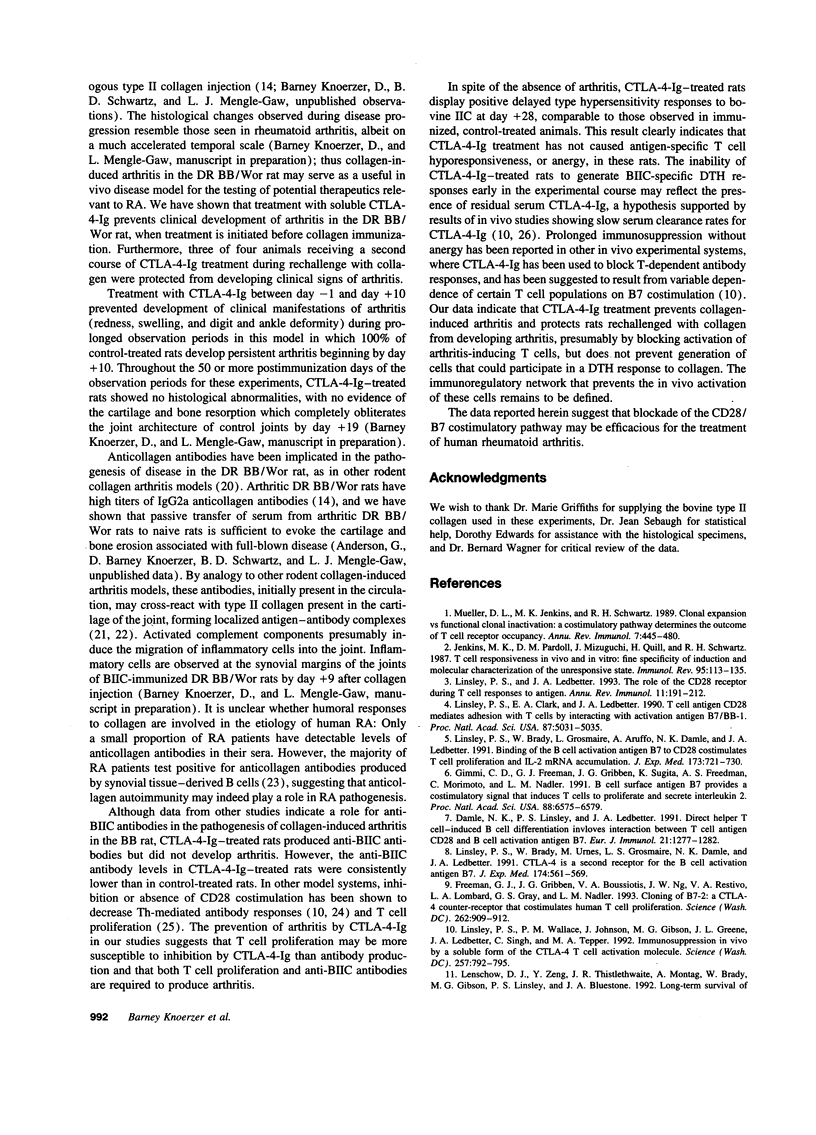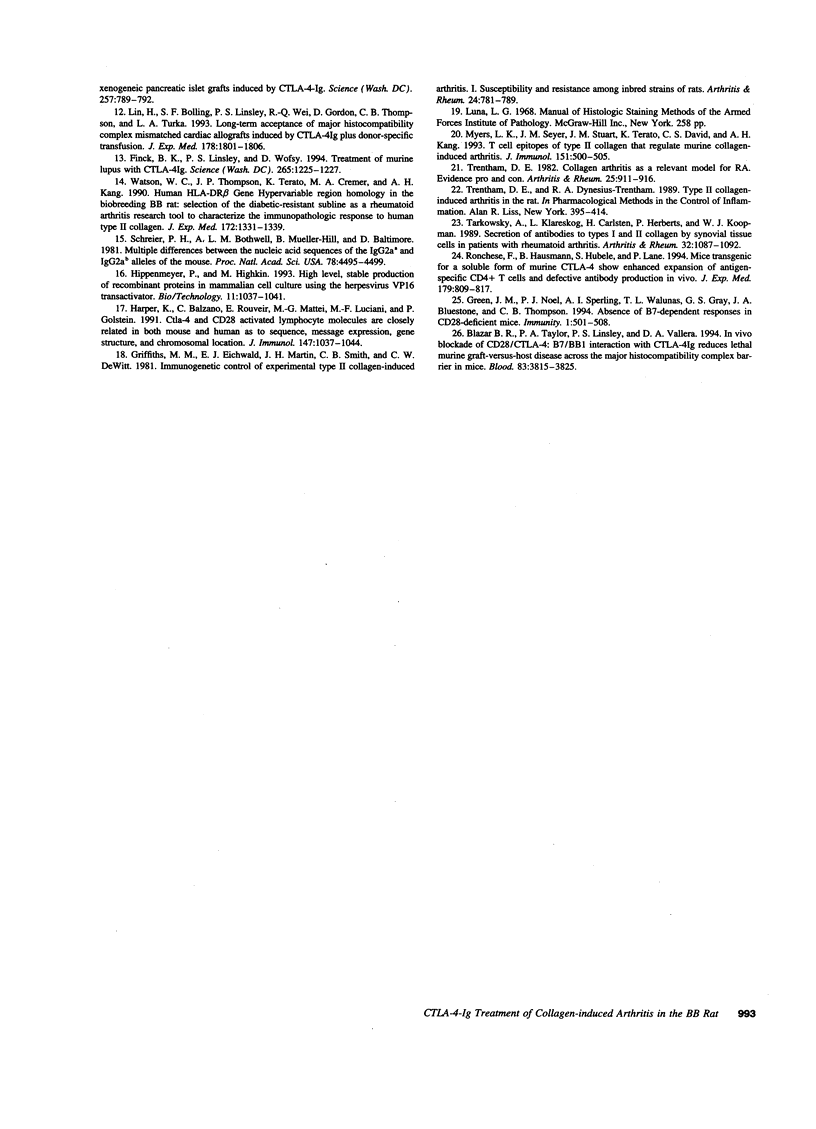Abstract
Antigen-specific T cell activation requires two independent signalling events, one mediated through T cell receptor engagement by the antigen-presenting cell-expressed peptide/class II major histocompatibility complex, and the second through the cognate interactions of costimulatory molecules expressed on the T cell and antigen-presenting cell. There is evidence from in vitro and in vivo experimental systems suggesting that the CD28/B7 costimulatory pathway is crucial for induction of maximal T cell proliferation and T helper-B cell collaboration for IgG production. This pathway can be blocked by CTLA-4-Ig, a soluble form of CTLA-4 which binds with high avidity to the CD28 ligands, B7-1 and B7-2. Here, we show that CTLA-4-Ig treatment prevents clinical and histological manifestations of disease in a collagen-induced arthritis model of rheumatoid arthritis in the diabetes resistant BB/Wor rat, when therapy is initiated before immunization with bovine type II collagen (BIIC). Anti-BIIC antibody titers are reduced in CTLA-4-Ig-treated rats compared to diseased control animals. Histologically, joints from CTLA-4-Ig-treated animals show no histological abnormalities, in contrast to control antibody-treated animals, which show complete erosion of the articular cartilage and bone. Despite the efficacy of CTLA-4-Ig in preventing clinical and histological signs of arthritis and reducing antibody responses to BIIC, delayed type hypersensitivity responses to collagen 18 d or more after CTLA-4-Ig treatment ends are similar in CTLA-4-Ig-treated and untreated rats, suggesting that the prolonged disease suppression observed does not result from induction of T cell anergy.
Full text
PDF






Images in this article
Selected References
These references are in PubMed. This may not be the complete list of references from this article.
- Blazar B. R., Taylor P. A., Linsley P. S., Vallera D. A. In vivo blockade of CD28/CTLA4: B7/BB1 interaction with CTLA4-Ig reduces lethal murine graft-versus-host disease across the major histocompatibility complex barrier in mice. Blood. 1994 Jun 15;83(12):3815–3825. [PubMed] [Google Scholar]
- Damle N. K., Linsley P. S., Ledbetter J. A. Direct helper T cell-induced B cell differentiation involves interaction between T cell antigen CD28 and B cell activation antigen B7. Eur J Immunol. 1991 May;21(5):1277–1282. doi: 10.1002/eji.1830210527. [DOI] [PubMed] [Google Scholar]
- Finck B. K., Linsley P. S., Wofsy D. Treatment of murine lupus with CTLA4Ig. Science. 1994 Aug 26;265(5176):1225–1227. doi: 10.1126/science.7520604. [DOI] [PubMed] [Google Scholar]
- Freeman G. J., Gribben J. G., Boussiotis V. A., Ng J. W., Restivo V. A., Jr, Lombard L. A., Gray G. S., Nadler L. M. Cloning of B7-2: a CTLA-4 counter-receptor that costimulates human T cell proliferation. Science. 1993 Nov 5;262(5135):909–911. doi: 10.1126/science.7694363. [DOI] [PubMed] [Google Scholar]
- Gimmi C. D., Freeman G. J., Gribben J. G., Sugita K., Freedman A. S., Morimoto C., Nadler L. M. B-cell surface antigen B7 provides a costimulatory signal that induces T cells to proliferate and secrete interleukin 2. Proc Natl Acad Sci U S A. 1991 Aug 1;88(15):6575–6579. doi: 10.1073/pnas.88.15.6575. [DOI] [PMC free article] [PubMed] [Google Scholar]
- Green J. M., Noel P. J., Sperling A. I., Walunas T. L., Gray G. S., Bluestone J. A., Thompson C. B. Absence of B7-dependent responses in CD28-deficient mice. Immunity. 1994 Sep;1(6):501–508. doi: 10.1016/1074-7613(94)90092-2. [DOI] [PubMed] [Google Scholar]
- Griffiths M. M., Eichwald E. J., Martin J. H., Smith C. B., DeWitt C. W. Immunogenetic control of experimental type II collagen-induced arthritis. I. Susceptibility and resistance among inbred strains of rats. Arthritis Rheum. 1981 Jun;24(6):781–789. doi: 10.1002/art.1780240605. [DOI] [PubMed] [Google Scholar]
- Harper K., Balzano C., Rouvier E., Mattéi M. G., Luciani M. F., Golstein P. CTLA-4 and CD28 activated lymphocyte molecules are closely related in both mouse and human as to sequence, message expression, gene structure, and chromosomal location. J Immunol. 1991 Aug 1;147(3):1037–1044. [PubMed] [Google Scholar]
- Hippenmeyer P., Highkin M. High level, stable production of recombinant proteins in mammalian cell culture using the herpesvirus VP16 transactivator. Biotechnology (N Y) 1993 Sep;11(9):1037–1041. doi: 10.1038/nbt0993-1037. [DOI] [PubMed] [Google Scholar]
- Jenkins M. K., Pardoll D. M., Mizuguchi J., Quill H., Schwartz R. H. T-cell unresponsiveness in vivo and in vitro: fine specificity of induction and molecular characterization of the unresponsive state. Immunol Rev. 1987 Feb;95:113–135. doi: 10.1111/j.1600-065x.1987.tb00502.x. [DOI] [PubMed] [Google Scholar]
- Lin H., Bolling S. F., Linsley P. S., Wei R. Q., Gordon D., Thompson C. B., Turka L. A. Long-term acceptance of major histocompatibility complex mismatched cardiac allografts induced by CTLA4Ig plus donor-specific transfusion. J Exp Med. 1993 Nov 1;178(5):1801–1806. doi: 10.1084/jem.178.5.1801. [DOI] [PMC free article] [PubMed] [Google Scholar]
- Linsley P. S., Brady W., Grosmaire L., Aruffo A., Damle N. K., Ledbetter J. A. Binding of the B cell activation antigen B7 to CD28 costimulates T cell proliferation and interleukin 2 mRNA accumulation. J Exp Med. 1991 Mar 1;173(3):721–730. doi: 10.1084/jem.173.3.721. [DOI] [PMC free article] [PubMed] [Google Scholar]
- Linsley P. S., Brady W., Urnes M., Grosmaire L. S., Damle N. K., Ledbetter J. A. CTLA-4 is a second receptor for the B cell activation antigen B7. J Exp Med. 1991 Sep 1;174(3):561–569. doi: 10.1084/jem.174.3.561. [DOI] [PMC free article] [PubMed] [Google Scholar]
- Linsley P. S., Clark E. A., Ledbetter J. A. T-cell antigen CD28 mediates adhesion with B cells by interacting with activation antigen B7/BB-1. Proc Natl Acad Sci U S A. 1990 Jul;87(13):5031–5035. doi: 10.1073/pnas.87.13.5031. [DOI] [PMC free article] [PubMed] [Google Scholar]
- Linsley P. S., Ledbetter J. A. The role of the CD28 receptor during T cell responses to antigen. Annu Rev Immunol. 1993;11:191–212. doi: 10.1146/annurev.iy.11.040193.001203. [DOI] [PubMed] [Google Scholar]
- Linsley P. S., Wallace P. M., Johnson J., Gibson M. G., Greene J. L., Ledbetter J. A., Singh C., Tepper M. A. Immunosuppression in vivo by a soluble form of the CTLA-4 T cell activation molecule. Science. 1992 Aug 7;257(5071):792–795. doi: 10.1126/science.1496399. [DOI] [PubMed] [Google Scholar]
- Mueller D. L., Jenkins M. K., Schwartz R. H. Clonal expansion versus functional clonal inactivation: a costimulatory signalling pathway determines the outcome of T cell antigen receptor occupancy. Annu Rev Immunol. 1989;7:445–480. doi: 10.1146/annurev.iy.07.040189.002305. [DOI] [PubMed] [Google Scholar]
- Myers L. K., Seyer J. M., Stuart J. M., Terato K., David C. S., Kang A. H. T cell epitopes of type II collagen that regulate murine collagen-induced arthritis. J Immunol. 1993 Jul 1;151(1):500–505. [PubMed] [Google Scholar]
- Ronchese F., Hausmann B., Hubele S., Lane P. Mice transgenic for a soluble form of murine CTLA-4 show enhanced expansion of antigen-specific CD4+ T cells and defective antibody production in vivo. J Exp Med. 1994 Mar 1;179(3):809–817. doi: 10.1084/jem.179.3.809. [DOI] [PMC free article] [PubMed] [Google Scholar]
- Schreier P. H., Bothwell A. L., Mueller-Hill B., Baltimore D. Multiple differences between the nucleic acid sequences of the IgG2aa and IgG2ab alleles of the mouse. Proc Natl Acad Sci U S A. 1981 Jul;78(7):4495–4499. doi: 10.1073/pnas.78.7.4495. [DOI] [PMC free article] [PubMed] [Google Scholar]
- Tarkowski A., Klareskog L., Carlsten H., Herberts P., Koopman W. J. Secretion of antibodies to types I and II collagen by synovial tissue cells in patients with rheumatoid arthritis. Arthritis Rheum. 1989 Sep;32(9):1087–1092. doi: 10.1002/anr.1780320906. [DOI] [PubMed] [Google Scholar]
- Trentham D. E. Collagen arthritis as a relevant model for rheumatoid arthritis. Arthritis Rheum. 1982 Aug;25(8):911–916. doi: 10.1002/art.1780250801. [DOI] [PubMed] [Google Scholar]
- Watson W. C., Thompson J. P., Terato K., Cremer M. A., Kang A. H. Human HLA-DR beta gene hypervariable region homology in the biobreeding BB rat: selection of the diabetic-resistant subline as a rheumatoid arthritis research tool to characterize the immunopathologic response to human type II collagen. J Exp Med. 1990 Nov 1;172(5):1331–1339. doi: 10.1084/jem.172.5.1331. [DOI] [PMC free article] [PubMed] [Google Scholar]







